Copyright & Fair-use Agreement
UNLV Special Collections provides copies of materials to facilitate private study, scholarship, or research. Material not in the public domain may be used according to fair use of copyrighted materials as defined by copyright law. Please cite us.
Please note that UNLV may not own the copyright to these materials and cannot provide permission to publish or distribute materials when UNLV is not the copyright holder. The user is solely responsible for determining the copyright status of materials and obtaining permission to use material from the copyright holder and for determining whether any permissions relating to any other rights are necessary for the intended use, and for obtaining all required permissions beyond that allowed by fair use.
Read more about our reproduction and use policy.
I agree.Information
Digital ID
Permalink
Details
More Info
Rights
Digital Provenance
Publisher
Transcription
BROWN SHOE CO. v. COMMISSIONER. 5 were debited to cash account on the assets side of petitioner’s ledger and were credited to earned surplus either upon receipt or after having first been assigned to contributed surplus. The values of the buildings acquired were set up in a building account on the assets side and were credited to surplus.5 In every instance the cash received by petitioner from a community group was less than the amount expended by it for the acquisition or construction of the local factory building and equipment. In computing its normal tax net income for the taxable years in controversy petitioner deducted depreciation on the buildings transferred by the community groups and on the full cost of the buildings and equipment acquired or enlarged in the communities from which it had received cash. Petitioner also included the total of $971,031.01 in cash and other property in its equity invested capital. The Commissioner disallowed depreciation deductions with respect to the buildings transferred (in the value of $85,471.56) and the properties acquired with cash to the extent paid to petitioner by the groups (in the value of $885,559.45).6 , In computing the amount of depreciation to be allowed, the Commissioner deducted that portion of the cost of the buildings, land and machinery which was paid with such contributed cash or equivalent funds.7 The Commissioner in making such reductions allocated the cash contribution to each item, such as buildings, land if any had been purchased, and machinery 5 Both courts below and the Commissioner have expressly assumed, as petitioner asserts, that the receipts of property and cash were not tax»eTdh aes Cinocmommies.sioner does not deny that such deductions were disallowed for the first time in 1943, following the decision in D etro it E d7i sonT hCeo . avm. oCuonmt mtihssuiso ndeirs, a3l1lo9w eTld. So'.n 98ac c(o1u94n3t) :of depreciation was y$e22a,r4 7e2n.d6e0d fo1r9 4t3h. e fTishcearl ey ewaars ennod edde t1e9r4m2i naantdi o$n2 4b,y3 0t7h.e1 0C ofmorm itshsei foinscearl of a deficiency in petitioner’s normal tax for either year.

